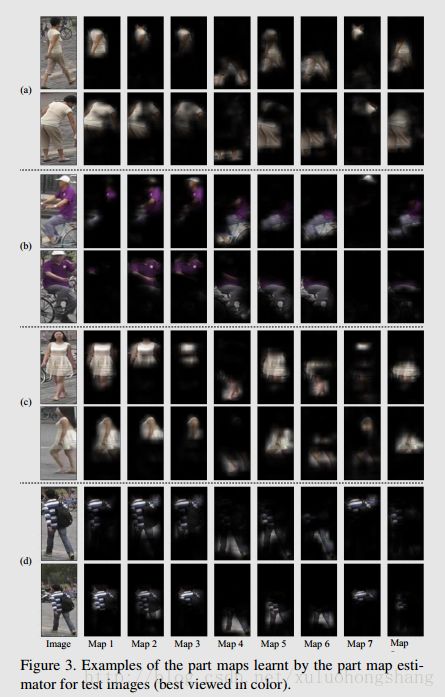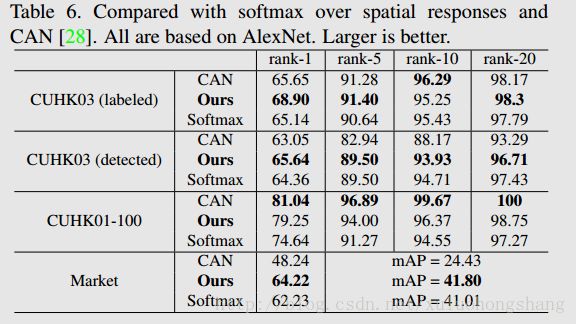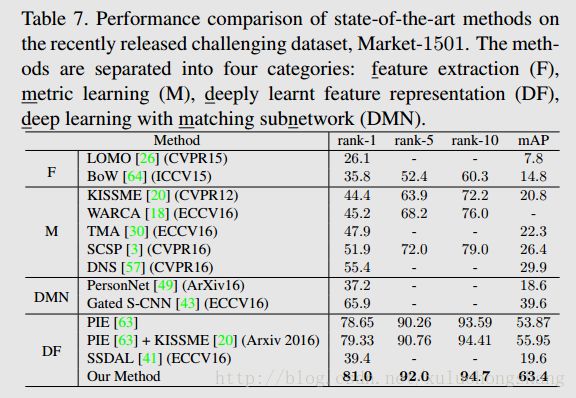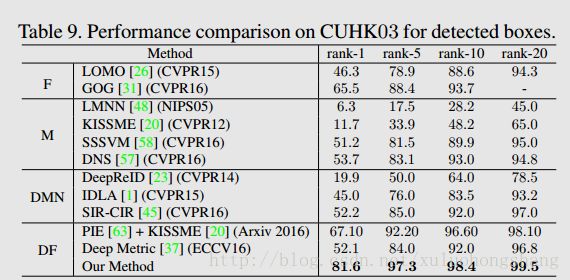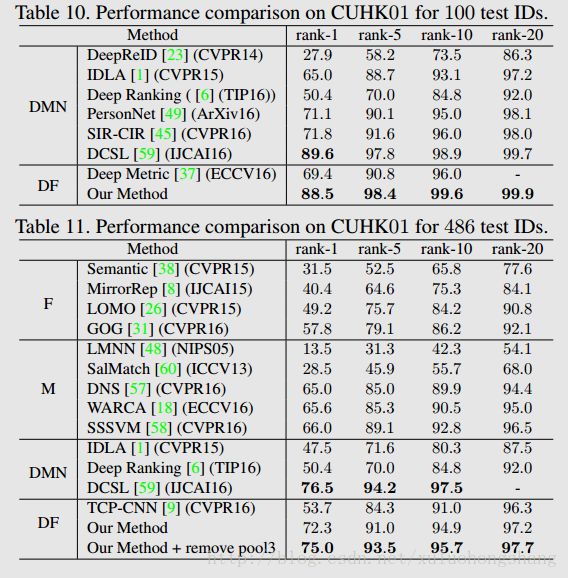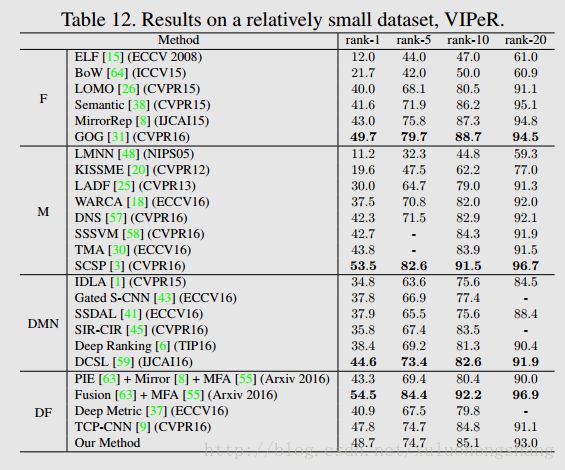part-aligned系列论文:1707.Deeply-Learned Part-Aligned Representations for Person Re-Identification 论文笔记
Deeply-Learned Part-Aligned Representations for Person Re-Identification一种超简单有效的行人对齐识别网络!
inspired by attention model,propose a part-aligned human representation基于特征图
FCN全卷积提取特征图部分应用GoogLeNet部分网络,特征图输入到K个分支的part net,整个model learnt from CUHK03,then 在其他数据集上fine-tune测试
be efficient in online matching and cheap in storage
采用triplet loss指导模型训练,无需人体部位标签信息
在Market-1501,CUHK03,CUHK01和VIPeR取得了最好的性能效果
公式描述部分很容易看懂
设计多分支partnet(Part Map detector(一个卷积+sigmoid代替softmax)+全局均值池化+线性维度缩减层(1个卷积层)),最后各part特征被L2 normalization后进行特征串接,符合行人由上倒下的序列关系,串接特征更具区分性,采用简单的
分spatial partition和Body part partition,该论文属于后者欧氏距离做匹配度量
作者的方法侧重在特征的更有效的表达(deeply learnt feature representation),同其他方法(如PIE)可一定程度上结合度量学习方法提升性能
其他基于部件对齐的论文:
CPM:S. Wei, V. Ramakrishna, T. Kanade, and Y. Sheikh. Convolutional pose machines. In CVPR, pages 4724–4732, 2016.
PIE:L. Zheng, Y. Huang, H. Lu, and Y. Yang. Pose invariant embedding for deep person re-identification. CoRR,abs/1701.07732, 2017(w/o using KISSME,uses ResNet-50,complicated fusion scheme)
使用复杂的匹配子网络解决对齐问题的论文:
F. Wang, W. Zuo, L. Lin, D. Zhang, and L. Zhang. Joint learning of single-image and cross-image representations for person re-identification. In CVPR, June 2016
IDLA:E. Ahmed, M. Jones, and T. K. Marks. An improved deep learning architecture for person re-identification. In CVPR, 2015.
Deepreid:W. Li, R. Zhao, T. Xiao, and X. Wang. Deepreid: Deep filter pairing neural network for person re-identification. In CVPR, 2014.
DCSL:Y. Zhang, X. Li, L. Zhao, and Z. Zhang. Semantics-aware deep correspondence structure learning for robust person reidentification. In IJCAI, pages 3545–3551, 2016.
PersonNet:L. Wu, C. Shen, and A. van den Hengel. Personnet: Personre-identification with deep convolutional neural networks. CoRR, abs/1601.07255, 2016.
Gated S-CNN:R. R. Varior, M. Haloi, and G. Wang. Gated siamese convolutional neural network architecture for human reidentification. In ECCV, pages 791–808, 2016
**SIR-CIR:**F. Wang, W. Zuo, L. Lin, D. Zhang, and L. Zhang. Joint learning of single-image and cross-image representations for person re-identification. In CVPR, June 2016
Deep Ranking:S.-Z. Chen, C.-C. Guo, and J.-H. Lai. Deep ranking for person re identification via joint representation learning. IEEE Trans. Image Processing, 25(5):2353–2367, 2016
SSDAL :C. Su, S. Zhang, J. Xing, W. Gao, and Q. Tian. Deep attributes driven multi-camera person re-identification. In ECCV, pages 475–491, 2016.
其他相关论文:
作者参考的采用了LSTM注意网络在特征图阶段进行匹配的论文:
R. R. Varior, M. Haloi, and G. Wang. Gated siamese convolutional neural network architecture for human reidentification. In ECCV, pages 791–808, 2016.
作者主要参考的其他两篇注意网络论文:
H. Liu, J. Feng, M. Qi, J. Jiang, and S. Yan. End-to-end comparative attention networks for person re-identification. CoRR, abs/1606.04404, 2016.(spatial attention model)
K. Xu, J. Ba, R. Kiros, K. Cho, A. C. Courville, R. Salakhutdinov, R. S. Zemel, and Y. Bengio. Show, attend and tell:Neural image caption generation with visual attention. InICML, pages 2048–2057, 2015(注意机制模型,作者参考的一篇论文)
作者着重参考的其他相关的论文(need to train a part/pose segmentation or detection model from the labeled part mask/box or pose ground-truth,):
S. Bak, E. Corvee, F. Br ´ emond, and M. Thonnat. Person ´ re-identification using spatial covariance regions of human body parts. In AVSS, pages 435–440, 2010.
Y. Xu, L. Lin, W. Zheng, and X. Liu. Human re-identification by matching compositional template with cluster sampling. In ICCV, pages 3152–3159, 2013.
D. S. Cheng, M. Cristani, M. Stoppa, L. Bazzani, and V. Murino. Custom pictorial structures for re-identification.In BMVC, pages 1–11, 2011
L. Zheng, Y. Huang, H. Lu, and Y. Yang. Pose invariant embedding for deep person re-identification. CoRR, abs/1701.07732, 2017.
similarity/metric learning techniques for handling pose misalignment:
D. Chen, Z. Yuan, G. Hua, N. Zheng, and J. Wang. Similarity learning on an explicit polynomial kernel feature map for person re-identification. In CVPR, pages 1565–1573, 2015.
D. Chen, Z. Yuan, B. Chen, and N. Zheng. Similarity learning with spatial constraints for person re-identification. In CVPR, June 2016.
Y. Shen, W. Lin, J. Yan, M. Xu, J. Wu, and J. Wang. Person re-identification with correspondence structure learning. In ICCV, 2015
partial person matching:W.-S. Zheng, X. Li, T. Xiang, S. Liao, J. Lai, and S. Gong.Partial person re-identification. In ICCV, December 2015.
以下论文基于假设:各bbox中行人图像各空间区域的空间分布和行人姿态及相应位置是相似的(实际中,bbox被detector检测,假设很难满足,即spatial partition is not well aligned with human body parts)
box horizontal stripes:
D. Yi, Z. Lei, S. Liao, and S. Z. Li. Deep metric learning for person re-identification. In ICLR, 2014.
D. Cheng, Y. Gong, S. Zhou, J. Wang, and N. Zheng. Person re identification by multi-channel parts-based cnn with improved triplet loss function. In CVPR, June 2016 R. R. Varior, B. Shuai, J. Lu, D. Xu, and G. Wang. A siamese long short-term memory architecture for human reidentification. In ECCV, pages 135–153, 2016.
box grids:
W. Li, R. Zhao, T. Xiao, and X. Wang. Deepreid: Deep filter pairing neural network for person re-identification. In CVPR, 2014.(subsequent complex matching techniques很小程度上来消除误对齐)
E. Ahmed, M. Jones, and T. K. Marks. An improved deep learning architecture for person re-identification. In CVPR, 2015.(subsequent complex matching techniques很小程度上来消除误对齐)
论文介绍
简介
通过阅读作者的论文,大致可将Part-Aligned分成四类,即基于mask掩膜的空间条纹(spatial strips)分割,基于mask掩膜的空间网格(spatial grids)分割,基于像素级细粒度分类的Person Body Segmentation(separate body part detection in reid)和基于特征图的Person Body Part Segmentation(可以实现端到端的训练),前两种是spatial partition-based local representation 方法。
论文中FCN为全卷积网络简写,FC为全连接网络简写。
作者实验:
The methods are separated into four categories: feature extraction (F), metric learning (M), deeply learnt feature representation (DF), deep learning with matching subnetwork (DMN).
Body part partition and spatial partition
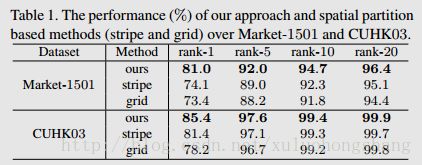
The number of parts.
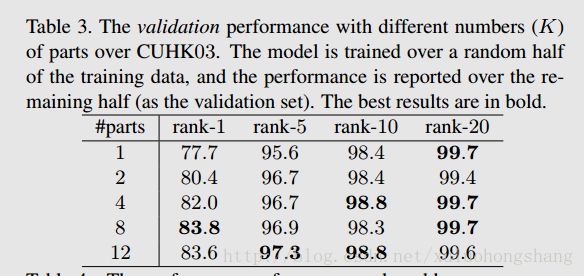
Human segmentation and body part segmentation

Comparison with non-human/part-segmentation

Image feature map extraction networks

Comparison with other attention models


